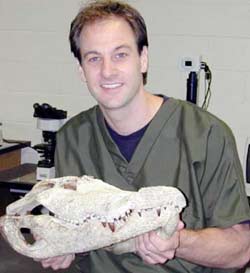Biological cycle of Tyrannosaurus dinosaurs
The newborn Tyrannosaurus typhoon had all the chances to live up to adulthood but at least it had to survive the first two years of life.

Dr. Gregory Erickson
(Photo: bio.fsu.edu)
Dr. Gregory Erickson of the University of Florida (USA) has confirmed this. He and his colleagues sought to determine the biological cycle of Tyrannosaurus dinosaurs.
The scientists observed a Tyrannosaurus dinosaur population of 22 animals belonging to the Albertosaurus sarcophagus genus. Their fossils are found in Alberta in Canada, 200 kilometers northeast of Calgary. According to archaeologists, this dinosaur population has died in a short time. The detection of many fossils in one place proves that they live in groups or at least in small groups.
According to Dr. Erikson, Tyrannosaurus dinosaurs may have biological cycles similar to long-lived mammals or mammals. Once you pass the threshold of the first two years of life - during this time baby dinosaurs can be prey to predators - it has many chances to live up to adulthood.
Between the ages of 2 and 13, the average Tyrannosaurus dinosaur mortality rate was 3.5%, so it had a chance to grow peacefully. This is explained by the fact that young dinosaur fossils are almost absent from museums.
But once the ' adolescence ' is over, the situation worsens: the mortality rate between the ages of 14 and 23 is 22.9%. The challenges of middle-aged reproductive life and lifestyle increase the risk of death in this age group. Tyrannosaurus species rarely live well to old age. Only one of the dinosaur fossils found has reached a relatively high age of 28 with signs of aging such as arthritis, calcium loss and other weakened diseases that often occur in mammals and other long-lived animals.

Tyrannosaurus dinosaur (Photo: dinosaur)
VN
- Tyrannosaurus has tens of times the bite
- The death smile of the tyrant dinosaur
- Find relatives of tyrant dinosaurs
- New discovery about 'favorite food' of tyrant dinosaurs
- Find new dinosaurs with relatives of tyrants
- New discovery about relatives of tyrants
- Tyrant dinosaurs cannot run for unexpected reasons
- The biting force of the tyrant dinosaur crushed three cars at the same time
- Tyrant dinosaurs had 'air conditioning' in mind
- Video: Stress 'great war' giant snake against tyrant dinosaurs
- Dinosaurs' hard to chew because of the crisis
- Tyrannosaurus is more violent than we think
 Discovered an ancient centipede fossil 99 million years old
Discovered an ancient centipede fossil 99 million years old Discovered bat-like dinosaurs in China
Discovered bat-like dinosaurs in China Discovered a 200-year-old bronze cannon of the coast
Discovered a 200-year-old bronze cannon of the coast Discover 305 million-year-old spider fossils
Discover 305 million-year-old spider fossils